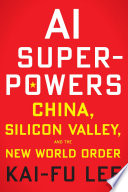

The book begins by highlighting the significant advancements in artificial intelligence (AI) in both China and the United States. The author, Kai-Fu Lee, emphasizes that while the U.S. has been a leader in AI research and development, China has rapidly caught up due to its vast amounts of data, government support, and a booming tech industry. Lee discusses how the U.S. has historically led in innovative AI technologies, but China’s approach to AI leverages its massive population and data resources to train AI models more effectively. This competition between the two superpowers is reshaping the global landscape of technology and economics. Lee also points out that while the U.S. focuses on fundamental research, China excels in applying AI technologies to real-world problems at scale. This duality creates a new dynamic in the global AI race, with both countries contributing uniquely to the field. Lee predicts that this competition will not only impact technological advancements but also the geopolitical landscape, as each nation seeks to establish itself as the dominant force in AI.
Continue readingOne of the foundational ideas in the book is the concept that data has become the new oil of the digital economy. Lee explains how data is essential for training AI algorithms and that the quantity and quality of data directly influence the effectiveness of AI applications. In China, the government and private companies have access to vast amounts of data from their citizens, which enables them to build better AI systems. This contrasts with the U.S., where privacy concerns and regulations limit data access. Lee argues that the ability to harness and utilize data effectively will determine the success of AI initiatives. He also discusses the implications of data ownership and privacy, raising questions about who should control this valuable resource. The book emphasizes that as data becomes increasingly crucial for AI development, nations and corporations must navigate the ethical landscape surrounding data usage and privacy.
Continue readingLee delves into the implications of AI on the workforce, addressing the potential for job displacement due to automation. He presents a nuanced view, acknowledging that while AI will likely replace many jobs, it will also create new opportunities. Lee categorizes jobs into three types: jobs that can be automated, jobs that require creativity and emotional intelligence, and jobs that involve complex human interactions. He predicts that low-skill jobs are most at risk of being automated, while jobs requiring human creativity and interpersonal skills will remain in demand. Lee advocates for a proactive approach to education and workforce training, emphasizing the need for individuals to adapt to the changing job landscape. He suggests that society must invest in reskilling and upskilling workers to prepare them for the jobs of the future. This discussion on the future of work is crucial, as it highlights the need for a societal response to the challenges posed by AI.
Continue readingThe book explores the broader economic implications of AI, particularly how it will reshape industries and economies globally. Lee argues that AI has the potential to increase productivity and economic growth, but it also poses challenges, such as rising inequality and job displacement. He discusses how countries that effectively leverage AI will gain a competitive edge in the global economy, while those that lag behind may face economic stagnation. Lee emphasizes the importance of collaboration between governments, businesses, and educational institutions to create an environment conducive to AI innovation. He also highlights the need for international cooperation in addressing the ethical and regulatory challenges posed by AI. The discussion of AI's impact on the global economy is vital for understanding the strategic importance of AI in the 21st century.
Continue readingLee emphasizes the critical role that governments play in shaping the future of AI. He discusses how government policies can either foster or hinder AI innovation. In China, the government has made AI a national priority, investing heavily in research and development and creating an ecosystem that supports AI startups. In contrast, Lee argues that the U.S. has been slower to adopt a cohesive national strategy for AI, which may hinder its competitive position. He advocates for a balanced approach where governments provide support for AI research while also addressing ethical concerns and ensuring that the benefits of AI are widely distributed. Lee’s insights into the role of government highlight the need for thoughtful policy-making in the face of rapid technological change.
Continue readingThe book addresses the ethical implications of AI development and deployment. Lee raises important questions about bias in AI algorithms, privacy concerns, and the potential for AI to exacerbate social inequalities. He emphasizes the need for ethical frameworks to guide AI development, ensuring that AI technologies are used responsibly and for the benefit of society. Lee advocates for transparency in AI systems and the inclusion of diverse perspectives in the development process to mitigate bias. The discussion of ethics in AI is crucial, as it underscores the responsibility of technologists and policymakers to consider the societal impacts of their innovations.
Continue readingFinally, Lee stresses the importance of collaboration and global cooperation in the AI space. He argues that the challenges posed by AI, such as job displacement and ethical concerns, require a collective response from nations, industries, and academia. Lee envisions a future where countries work together to establish international standards for AI development and deployment, fostering an environment of trust and collaboration. He believes that by sharing knowledge and resources, the global community can harness the full potential of AI while addressing its challenges. This call for collaboration is a powerful reminder of the interconnectedness of our world and the need for cooperative solutions in the face of complex global issues.
Continue reading